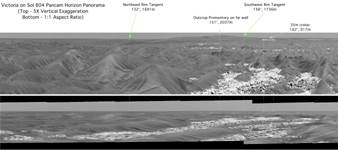
Stretched View Showing 'Victoria'This pair of images from the panoramic camera on NASA's Mars Exploration Rover Opportunity served as initial confirmation that the two-year-old rover is within sight of "Victoria Crater," which it has been approaching for more than a year. Engineers on the rover team were unsure whether Opportunity would make it as far as Victoria, but scientists hoped for the chance to study such a large crater with their roving geologist. Victoria Crater is 800 meters (nearly half a mile) in diameter, about six times wider than "Endurance Crater," where Opportunity spent several months in 2004 examining rock layers affected by ancient water.
When scientists using orbital data calculated that they should be able to detect Victoria's rim in rover images, they scrutinized frames taken in the direction of the crater by the panoramic camera. To positively characterize the subtle horizon profile of the crater and some of the features leading up to it, researchers created a vertically-stretched image (top) from a mosaic of regular frames from the panoramic camera (bottom), taken on Opportunity's 804th Martian day (April 29, 2006).
The stretched image makes mild nearby dunes look like more threatening peaks, but that is only a result of the exaggerated vertical dimension. This vertical stretch technique was first applied to Viking Lander 2 panoramas by Philip Stooke, of the University of Western Ontario, Canada, to help locate the lander with respect to orbiter images. Vertically stretching the image allows features to be more readily identified by the Mars Exploration Rover science team.
The bright white dot near the horizon to the right of center (barely visible without labeling or zoom-in) is thought to be a light-toned outcrop on the far wall of the crater, suggesting that the rover can see over the low rim of Victoria. In figure 1, the northeast and southeast rims are labeled in bright green. Finally, the light purple lines and arrow highlight a small crater.
